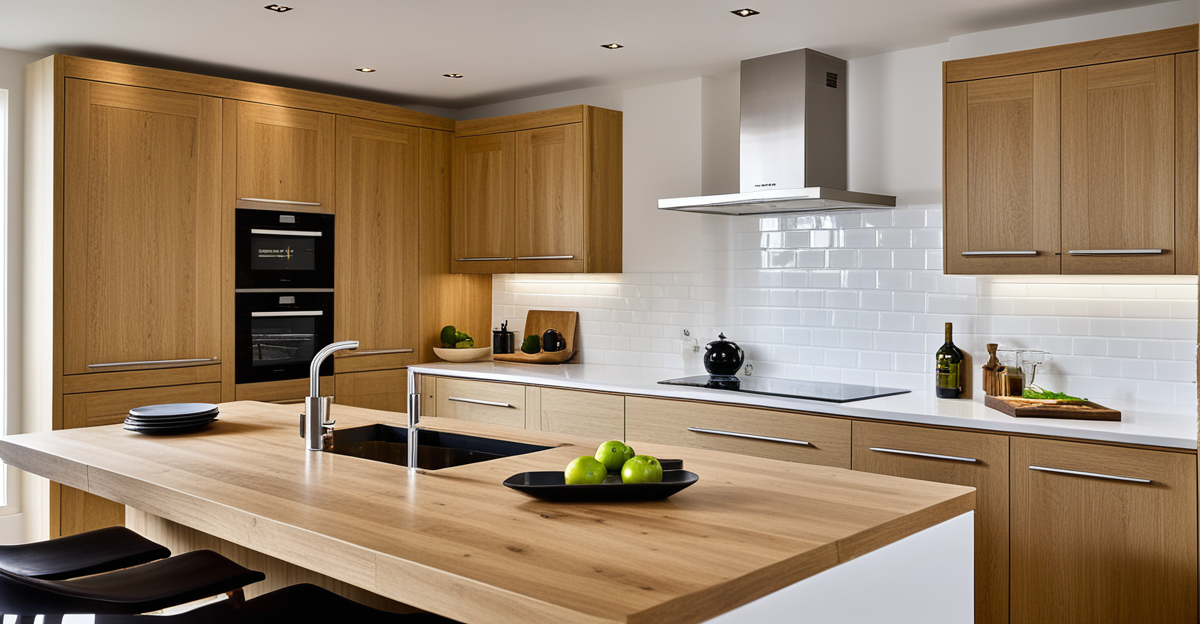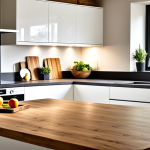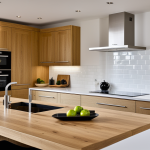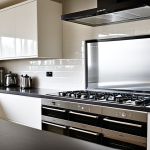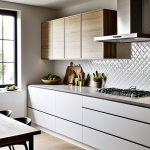Key Principles for Designing Efficient UK Kitchens
Designing efficient kitchens UK begins with understanding the unique challenges and dimensions of UK homes. Efficiency strategies focus on making every square foot count, ensuring smooth workflow and minimal wasted movement. A crucial element is tailoring the UK kitchen layout to the household’s lifestyle and space restrictions, optimizing zones for cooking, preparation, and storage.
In UK kitchen design, the concept of zoning plays a pivotal role. Arranging areas to separate cooking, cleaning, and food storage reduces clutter and enhances accessibility. Incorporating the classic work triangle—connecting the sink, stove, and refrigerator—ensures that tasks flow naturally and reduce fatigue.
In the same genre : How Can You Design a Sleek and Stylish Kitchen in Limited Space?
When planning a renovation or new build, integrating efficiency from the outset is imperative. This includes choosing appropriately sized fixtures and appliances that fit UK kitchen dimensions without overcrowding. Thoughtful layout planning prevents costly alterations later and fosters a harmonious environment.
Additionally, considering ergonomics and the typical kitchen traffic flow helps avoid bottlenecks. This is especially relevant in UK homes, where kitchens often serve multiple purposes. By combining these efficiency strategies with smart storage choices and adaptable workspaces, homeowners can achieve a functional and inviting kitchen tailored to UK living demands.
Also to discover : What Are the Essential Tips for Designing a Slim Kitchen in the UK?
Optimising Kitchen Layouts for UK Homes
Understanding popular UK kitchen layouts is crucial when aiming for efficiency. The galley kitchen UK design, characterised by two parallel work surfaces, is ideal for narrow spaces, offering excellent workflow between cooking zones. Its linear form supports efficient movement, minimising unnecessary steps. Meanwhile, the L-shaped kitchen suits corner rooms and opens up space, allowing for flexible appliance placement and better kitchen traffic flow.
Another notable layout is the U-shaped kitchen, which wraps three walls. Though space-intensive, it maximises countertop area while preserving the principle of the work triangle—an essential efficiency strategy in UK kitchen design. The work triangle connects the sink, stove, and fridge, creating a natural, fluid workflow that cuts down on fatigue and wasted steps.
Tailoring kitchen traffic flow optimally means understanding household habits and spatial limits. For instance, in busier UK homes, separating zones reduces bottlenecks, improving efficiency further. Strategically positioning entrances and exit points helps maintain smooth movement through these layouts. Since efficient kitchens UK often face spatial constraints, employing flexible layouts like L-shaped or galley designs can transform tight kitchens into highly functional environments. Finally, incorporating zoning within these layouts maintains clarity among food prep, cooking, and cleaning areas, reinforcing organisation and productivity.
Space-Saving Solutions for Compact UK Kitchens
In small kitchens UK, implementing effective space-saving solutions is essential. Compact kitchen design demands clever use of every inch, often achieved through built-in storage options tailored to typical UK kitchen dimensions. For instance, tall cabinets extending up to the ceiling maximise vertical space, reducing clutter while maintaining accessibility.
Multi-functional furniture plays a pivotal role in these efficient kitchens UK. Foldable dining tables or extendable countertops adapt to varying needs, enhancing usability without permanent space consumption. Incorporating pull-out shelves and organisers within cupboards can transform narrow gaps or awkward corners into valuable storage, crucial in UK kitchen design where space is limited.
Utilising vertical storage strategies is a hallmark of compact kitchen design across UK homes. Wall-mounted racks for utensils, magnetic strips for knives, and overhead pot rails enable homeowners to keep surfaces clear, maintaining workflow efficiency. Alcoves and recesses, common in older UK houses, can be converted into smart storage nooks or appliance stations.
By combining these space-saving techniques, efficiency strategies in UK kitchens not only improve functionality but also preserve the open, inviting feel desired in modern kitchen environments. These solutions exemplify how thoughtful design can surmount the challenges posed by compact UK kitchen layouts.
Strategic Appliance Placement for Efficiency
Efficient appliance placement is vital in UK kitchen design to streamline cooking and cleaning tasks. In efficient kitchens UK, major appliances like the fridge, oven, and dishwasher should be positioned to uphold the classic work triangle, minimising movement between these key points. For example, placing the fridge near the kitchen entrance provides quick access for unloading groceries without disrupting cooking flow.
Choosing space-efficient appliances is crucial, especially in compact UK kitchens. Slimline and integrated appliances fit small spaces while maintaining functionality, helping maximise available countertop and cabinetry areas. Stackable washer-dryers or combination ovens further optimise limited space, reducing clutter and allowing smoother kitchen traffic flow.
Ergonomics plays a key role in appliance layout. Counters are best matched to appliance heights to avoid bending or stretching, reducing fatigue. For instance, mounting ovens at eye level enhances accessibility and safety. Also, positioning dishwashers near sinks simplifies loading and unloading, supporting efficient workflows.
By considering appliance size, type, and location, appliance placement UK strategies ensure kitchens not only look streamlined but function at peak efficiency. This alignment with overall UK kitchen design improves daily convenience and supports a harmonious cooking environment tailored to UK homes’ specific spatial needs.
Key Principles for Designing Efficient UK Kitchens
Designing efficient kitchens UK demands a tailored approach centered on UK kitchen design realities. Efficiency strategies begin with assessing the home’s spatial constraints and household routines to optimise the UK kitchen layout. Efficiency is not just space-saving; it means fostering smooth workflows and reducing unnecessary steps.
Applying core principles such as the work triangle remains fundamental. Connecting the sink, stove, and fridge within easy reach supports a natural cooking sequence, reducing fatigue and boosting productivity. These points, along with designated zones for preparation, cooking, and cleaning, anchor practical efficiency strategies.
Planning from the outset is crucial. Early integration of custom cabinetry sized for UK units and appliances helps avoid compromises later in the remodel. Consideration of ergonomics—like counter height and clearances—ensures the space feels comfortable and user-friendly day-to-day.
Efficient kitchens UK often combine flexibility with functionality. Modular storage, pull-out cupboards, and adjustable shelving can adapt to evolving needs. Thoughtful lighting placement and ventilation also enhance usability without sacrificing design flow.
By embedding these principles, homeowners achieve not only a functional kitchen but a cohesive environment that elevates daily cooking and living experiences within the typical UK home setting.
Key Principles for Designing Efficient UK Kitchens
Designing an efficient kitchen UK starts by aligning UK kitchen design with practical and spatial realities. The first step involves careful assessment of the existing UK kitchen layout to identify workflow bottlenecks and optimise the use of every centimetre. A well-planned layout prioritises zones for cooking, preparation, and cleaning, reducing unnecessary steps and improving productivity.
One proven efficiency strategy is embedding the work triangle—linking sink, stove, and fridge—within easy and natural reach. This encourages a smooth sequence of kitchen tasks, minimising fatigue. However, unlike generic designs, UK kitchens require adaptations for specific spatial constraints, appliances size, and typical household habits, reinforcing the need for tailored solutions.
An early-stage inclusion of custom storage and cabinetry fitted to UK standard dimensions supports clutter reduction, thus enhancing workflow. Ergonomic factors like appropriate counter heights and sufficient clearances prevent discomfort, which is vital since UK kitchens often serve multiple purposes beyond cooking.
Incorporating modular, flexible elements such as pull-out cupboards or adjustable shelving allows for a more adaptable space, meeting evolving needs over time. Altogether, these efficiency strategies rooted in sound UK kitchen design principles guarantee kitchens that are both functional and comfortable.
Key Principles for Designing Efficient UK Kitchens
Efficiency in UK kitchen design fundamentally relies on understanding spatial limitations and household routines to create an optimised UK kitchen layout. The cornerstone of these efficiency strategies is the classic work triangle—linking the sink, stove, and fridge—to ensure a seamless workflow. Proper zoning segregates cooking, preparation, and cleaning areas, cutting down unnecessary movement and enhancing productivity in efficient kitchens UK.
Incorporating these principles early during renovations or remodels allows for the integration of bespoke cabinetry and custom storage solutions designed to UK housing dimensions. For example, pull-out cupboards and adjustable shelving not only maximise space but also adapt to changing needs. Ergonomic considerations such as counter height and clearances minimise strain during use, which is essential in typically compact UK kitchens.
Effective UK kitchen design also demands flexible layouts that accommodate multiple users and chores simultaneously, addressing the multifunctional nature of modern UK homes. Lighting and ventilation placement, though often overlooked, significantly contribute to a comfortable and efficient cooking environment. By balancing these elements, homeowners can achieve streamlined spaces that prioritise both functionality and comfort tailored to the UK context.

